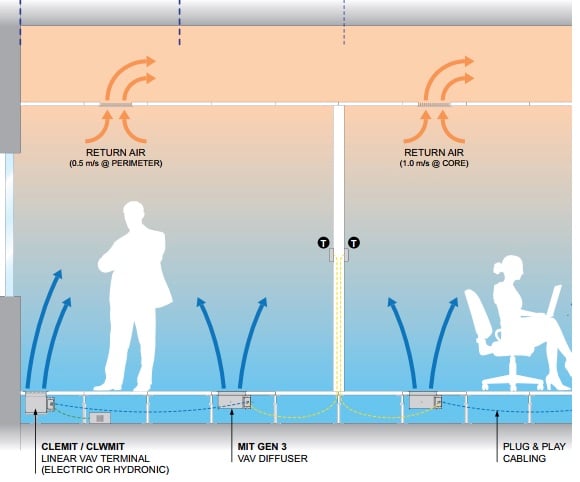5 Myths About UFAD Systems
Debunking 5 Myths About UFAD: Underfloor Air Distribution Underfloor air distribution can be a great option for any business or home. Its...
Floor, wall and ceiling mounted to meet your unique project design.
Air quality impacts productivity, especially in offices, and Underfloor Air Distribution Systems (UFAD systems) are a cost-efficient solution. With a UFAD, conditioned air is supplied from beneath the floor, rather than more traditional ceiling options. Compared with the conventional overhead system, UFADs offer cooling closest to an occupied zone.
In this article, you’ll learn about UFAD systems, their design, advantages, what to look for in a UFAD, and how they can help you save money on energy consumption.
Contrasting against traditional overhead systems, UFAD systems supply air conditioning through an underfloor gap known as the underfloor plenum. This gap is between structural concrete and the underside of a raised floor, and the HVAC system supplies cool air through a number of floor-level supply outlets–openings in the floor that can take any of a number of design styles.
As you consider a traditional ceiling-mounted air system vs. a UFAD system, there are some benefits of underfloor systems you should consider, including:
Centering a building’s operational needs—such as heating and ventilation—with necessary power and data cabling in one area under a raised access floor saves cost and stress when it comes time to reconfigure the space. UFAD system design is particularly popular in office buildings, due to the space for cabling and benefits of floor-based air conditioning.

While you’ve already learned the essentials of UFAD system design, you should also know about the key differences between UFAD and ceiling systems For example, ceiling systems:
In contrast, as the UFAD air handling units (ahu) supplies air from the plenum, this air is free to move through outlets like floor diffusers. An added bonus of UFAD is how the air is stratified: Warm air, along with pollutants, tends to rise, providing better air quality. Exhaust can also be removed with less energy.
Some types of diffusers, examples of supply outlets that help with air flow, include:
Thanks to the UFAD systems, higher air quality means higher productivity for your office space, and makes your office a more comfortable place to work.
| Learn more about the importance of air quality and UFAD with these blogs: |
One of the most important elements to look for in UFAD system design is that it was built along industry-specific guidelines: The ASHRAE UFAD design guide provides details from planning to operation of a UFAD, while providing more detail about the differences between UFAD and other air systems. ASHRAE’s guide also has results from laboratory and field experiments.
Additionally, the ASHRAE UFAD design guide is a critical tool for those interested in these systems, including facility managers, building owners, and technicians. As an added resource, the operations and maintenance (O&M) supplement features advice on ongoing maintenance.
Another essential component of choosing a UFAD system over an overhead option is the impact on energy consumption and upfront costs. Though upfront costs for installation may be somewhat more than the alternative, you can save money through:
AirFixture, an industry leader in UFAD for over 15 years, distributes systems that exceed ASHRAE air quality standards. As an added bonus, company materials are manufactured from non-toxic raw materials with high levels of recycled matter. Dedicated to quality customer services and UFAD products, AirFixture delivers with better materials.
Contact us today to get your UFAD system running.
Featured Photo Source: Nastuh Abootalebi

Debunking 5 Myths About UFAD: Underfloor Air Distribution Underfloor air distribution can be a great option for any business or home. Its...
Indoor Air Quality Directly Impacted by Floor Air Distribution

Until the 1970s, there was one primary method to deliver ventilation and conditioned air into commercial spaces. The traditional HVAC system, which...
